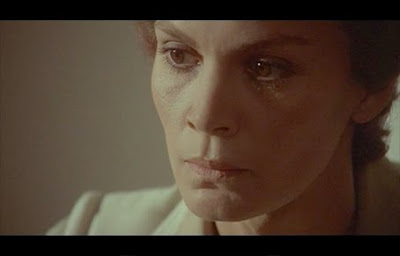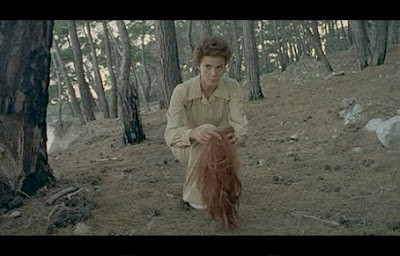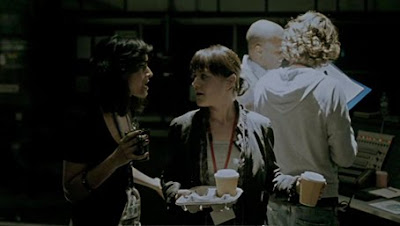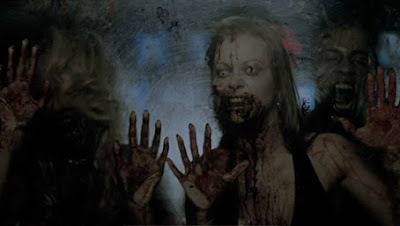Tuesday, November 24, 2009
COMPETITION! - Now over...
Monday, November 23, 2009
Footprints on the Moon

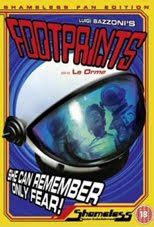
Thursday, November 19, 2009
Dead Set

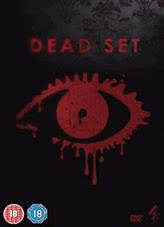
Directed by: Yann Demange
England, 2008
Horror /Drama / TV Serial, 141 min
Distributed by: Channel 4
I wanted to avoid posting on TV Serials that I have been watching over the past thirty odd years, as there are way to many (but still they are fantastic one hour studies of storytelling and the magic of small screen narrative) but the TV show Dead Set has to go up here. It’s unlike anything that I have seen before, well sort of, as it reminds me of the classic Day of the Triffids directed by Ken Hannam in 1981 or Martin Campbell's haunting Edge of Darkness from 1986 with the great Bob Peck in the lead, where each episode had me gasping in fear as the apocalypse was apparently looming just around the corner. As an adult I’ve spent many a hour in front of the tube watching great TV serials, but not too many have drawn me in like Dead Set did.
Dead Set drew me in with a vengeance and it makes for great entertainment. As I work with TV production myself, I’ve been in those reality show backrooms that are so wonderfully displayed during the first episode (and featured throughout the show), and they have got it down to speck. I't as realistic as it could ever be. The obnoxious producer barking orders, the crew staffer reading the paper instead of doing his job, the camera crews who sluggishly pull on through as long as you feed them coffee and snacks, and the assistant that does what they are told to with out openly objecting. Just like Kelly [Jamie Winstone] in the show. There’s a wonderful eye for detail going on here as the women are dressed in different ways the higher up the hierarchy they are. Kelly the runner is all t-shirt, jeans and sneakers, the producer’s assistant is dressed in a more fashionable, trendy way and the blokes, well they look just like all blokes in TV produciton do. Ironic t-shirts, baggy pants, unshaven and with a self-image of being hipper than they are. (It takes one to know one right!) . The producer is the tyrant of the operation; he thinks the world revolves round him and his show, and objects loudly when the global catastrophe threatens his show from going on the air, after all His production is the centre of the universe. However unreal this scene may seem to you, it is a very real scenario. I’ve been there, I’ve heard those discussions, I'v seen producers huff at external realism and complain that "that had to happen today when we go on air didn't it!". And it was just as surreal as it is portrayed on Dead Set. After 9/11 we had the discussion whether to air or not air a pig getting slaughtered for food on the reality farm show that I was working with back then. Needless to say the discussion was bizarre and unreal in the context that some three thousand people just died in the largest terrorist attack on the US since Pearl Harbour. But our little show had to go on, it still had to be the centre of attention… a strange situation indeed. Like said, it does happen. And just for the record, I have enough self insight to acknowledge that I’ve been quite a bastard myself when I used to produce reality for TV, so in some ways I can empathise with Patrick the bastard producer [Andy Nyman] after all, and the opening episode of Dead Set is a great presentation of a world that I know ever so well, which definitely helps sell the illusion to me when the shit hit’s the fan - although I never dissected a reality show cast member or rammed a rod through the head of the host.
 Created and written by Charlie Brooker, Dead Set was broadcast on UK television for five consecutive nights (yeah, five like the number of shows, no waiting the whole week with this one…) on Channel 4’s pay-TV site E4 and was such a success that the show was later rerun in three one hour instalments on Channel 4 in early 2009. A few weeks ago, during Halloween the show was shown in a marathon screening where all five episodes aired back to back. Director Yann Demange has only been directing TV for a few years, but has several hip and successful serials to his record proving that this is a guy who knows what he is doing. It’s also from these hip and modern serials that the majority of the cast have been taken.
Created and written by Charlie Brooker, Dead Set was broadcast on UK television for five consecutive nights (yeah, five like the number of shows, no waiting the whole week with this one…) on Channel 4’s pay-TV site E4 and was such a success that the show was later rerun in three one hour instalments on Channel 4 in early 2009. A few weeks ago, during Halloween the show was shown in a marathon screening where all five episodes aired back to back. Director Yann Demange has only been directing TV for a few years, but has several hip and successful serials to his record proving that this is a guy who knows what he is doing. It’s also from these hip and modern serials that the majority of the cast have been taken.
The tension takes a grip after the initial set up of main characters and shifts into horror territory quite fast. Each episode weaves its own impressive narrative forward with several arches being started and ended in each show, with nothing being left to chance or wanting more explanation. You won’t find yourself asking, “What about those fucking polar bears mate?” in this show. The first episode is almost a school book example of how you present you archetypes in the most effective way; the final episode is quite unpredictable and has been built-up to with major skill. Episode four with the boat ride on the river is among one of the most intense I’ve seen on a TV show, it’s really powerful stuff that will keep you on the edge of your seat as you never know what is lurking round the next bend.
Jamie Winstone [who you may have seen in the disturbing Donkey Punch 2008 and also the daughter of the Ray Winstone] Kelly is adorable, and definitely the person who carries this series on her shoulders. She’s set up from the start as an optimistic and ambitious. She doesn’t question her many small tasks, go for coffees, get the producer’s nicorettes, running errands, She does her job, she’s polite and is ambitious. You can’t not like that. I like her even more as I know how important those seemingly small and unimportant tasks are on a shoot. The runners are incredibly important as they are the ones that keep everyone else happy and on their feet during production. Without them things would certainly come to a grinding halt pretty fast. So this adds to her value in my eyes.
During the coarse of the narrative she develops, her character grows, and the backbone of her ambition comes to full power, as she becomes the fighting force of the show. Then there’s the personal and more complex side of her that lures us into liking her. She’s just spent a night of carnal joy with one of the other staffers, which makes us like her as we are always suckers for a love story, but then her relationship with Riq [Riz Ahmed] is exposed and her guilt towards him after her little slip. It would be easy to frown upon Kelly here, but we don’t even though she’s been unfaithful to Riq we stay with her. This because she obviously regrets her little mistake, she does still love Riq and this is very apparent in her second encounter with the guys from the crew after Kelly has talked to Riq on the phone. She is almost rejects him and pets Riq's image on her mobile phone at each given opportunity. Kelly is having regrets, she's feeling guilt and this makes her an empathetic character that we can relate to. It set's her up for the big journey she has affront of her and we root for her as she takes on the task.
Remember the back bone of great characters (or participants in your reality programme if you like) is identification + empathy = engaging characters.
 The Riq character is great. His fighting spirit is awesome, he fights for Kelly before the outbreak, he questions what happened between them, why the space, which indicates that he too still loves Kelly and wants’ things to be as they where before she started her new line of work. The interrupted phone call motivates him to go on a search after Kelly as he want' to finish the valuable discussion. Riq is obviously threatened by her new workspace, but puts all shallow emotions to one side when he realises that Kelly is still alive and sets out to save her. A line from the The Smiths song There is a Light that Never Goes Out comes to mind ”To die by your side is such a heavenly way to die…” which in some ways sums up Riq’s journey. He knows that the ordinary world is lost, there is nothing left out there but death, destruction and the zombies, so he seeks out the one thing he holds closest to his heart; Kelly.
The Riq character is great. His fighting spirit is awesome, he fights for Kelly before the outbreak, he questions what happened between them, why the space, which indicates that he too still loves Kelly and wants’ things to be as they where before she started her new line of work. The interrupted phone call motivates him to go on a search after Kelly as he want' to finish the valuable discussion. Riq is obviously threatened by her new workspace, but puts all shallow emotions to one side when he realises that Kelly is still alive and sets out to save her. A line from the The Smiths song There is a Light that Never Goes Out comes to mind ”To die by your side is such a heavenly way to die…” which in some ways sums up Riq’s journey. He knows that the ordinary world is lost, there is nothing left out there but death, destruction and the zombies, so he seeks out the one thing he holds closest to his heart; Kelly.
The supporting cast is grand and many of them do have smaller arches during the series, all on larger and smaller levels. One brilliant detail is the common centrefold dolly bird Veronica played by Beth Cordongly. As soon as she realises that there’s nobody watching her on the telly, the skimpy provocative clothing goes back in her suitcase and she starts wearing normal clothes. It’s a great little detail that is in there, and the show is filled with these smaller but splendid little details that work like a charm.
 You can never underestimate star value, and the choice of using the real host of Big Brother UK, Davina McColl (and other former BB cast members), as herself is brilliant. Davina brings a certain authenticity to the show that can’t be caught with an actor portraying someone in her shoes. This together with Pippa [Kathleen McDermott] being evicted during a real Big Brother eviction night and the vey realistic ”behind the scenes” opening really set the realism of the story firmly and solid. The craftsmanship sells me the illusion and I believe in the story.
You can never underestimate star value, and the choice of using the real host of Big Brother UK, Davina McColl (and other former BB cast members), as herself is brilliant. Davina brings a certain authenticity to the show that can’t be caught with an actor portraying someone in her shoes. This together with Pippa [Kathleen McDermott] being evicted during a real Big Brother eviction night and the vey realistic ”behind the scenes” opening really set the realism of the story firmly and solid. The craftsmanship sells me the illusion and I believe in the story.
Logic gaps, yeah there are few, not many, but a few, the biggest being the Big Brother live feed… I would think that if all mobile communication and TV broadcasts had gone off the air, even the emergency broadcasts, then I’d doubt that the BB live feed would still be online. But then again it does have a purpose and it gives Riq that motivation he needs for that suspenseful pursuit after Kelly.
 Now you can’t have a zombie movie without gore drenched special effects. People need to be torn apart, head’s need to be shot open, entrails need to be yanked out of screaming bodies and you need to drown the screen in blood and guts. Dead Set showcases an highly impressive amount of high-end effects courtesy of Neal Champion and his crew who has worked on a multitude of UK TV shows and films and noteworthy worked on one of my all-time faves Richard Stanley’s Hardware back in 1990. The effects are definitely top notch, and even surpass most of the classic eighties zombie stuff by far. It’s realistic, gory and very disturbing. This definitely adds to the charm of this fantastic series.
Now you can’t have a zombie movie without gore drenched special effects. People need to be torn apart, head’s need to be shot open, entrails need to be yanked out of screaming bodies and you need to drown the screen in blood and guts. Dead Set showcases an highly impressive amount of high-end effects courtesy of Neal Champion and his crew who has worked on a multitude of UK TV shows and films and noteworthy worked on one of my all-time faves Richard Stanley’s Hardware back in 1990. The effects are definitely top notch, and even surpass most of the classic eighties zombie stuff by far. It’s realistic, gory and very disturbing. This definitely adds to the charm of this fantastic series.
Yes, these zombies move fast, and I’m not even going to get in on the debate over slow vs. Fast zombies, because it’s not important. Sure in some ways the slow shuffling of the dead in the Romero universe is great, but the Zombies loose some of their threat when you can just walk past them at ease. There’s a great scene in Tom Savini’s remake of Night of the Living Dead 1990, where Barbara [Patricia Tallman] in a surprise twist to the original suits up and walks through the field easily shooting off the zombies one at a time which kind of proves my point. They just don’t really impend that much of a threat if you watch your step. Being a man of stern traditions, I want stuff to be what they are. Vampires avoid crosses and can’t stand garlic, Werewolves only turn at the new moon, and zombies are dead meat and can’t run. But if you bring your own twist to that, Vampires say they made up the Crosses and Garlic bit to fool us humans into believing they have a weakness, Werewolves can change at any given time due to special UV lamps, Zombies run because they like the thrill of the chase, then that’s fine with me. But keep in mind that all great antagonists need a really fragile Achilles heel. There has to be that on glimmer of chance that we can beat it. But fast zombies scare the heck out of me, because where my physical condition will allow me to run for a certain while, my body will eventually say stop, as lactic acid will become an obstacle. But a dead being that only wants to devour my flesh won’t, as its only impulses are EAT! So yeah they do scare me more than the common shuffler, but I feel that you have to use the right variety and twist on the monster that suits your project the best and if you use them right then who am I to complain.
Zombies and a world taken over by the dead is a very bleak prospect and leave a harrowing state of mind behind. Just imagine yourself in a world where you are being constantly targeted as something’s dinner, and the constant threat of one simple bite ending your life. It’s dark, sinister and nihilistic. If there’s one thing I dislike about zombie flicks it’s the happy go lucky endings that sometimes are pinned onto them. Sure it’s heart-warming to see Shaun and Ed reunited at the end of Edgar Wright’s Shaun of the Dead 2004, the jet’s spotting Selena, Hannah and Jim’s HELP sign at the end of Danny Boyle’s masterful 28 Days Later 2002, still brings tears to my eyes and I still draw a sigh of relief at the end of Romero’s Dawn of the Dead 1979 as the helicopter pulls away from the Monroeville Mall. But they still leave so much questions hanging in limbo with their partial endings. Even the ”everything’s going to be all right” endings of films like Night of the Living Dead 1968 and Day of the Dead 1985 are somewhat insufficient as nothing really has changed, the zombies, the virus, the threat is still out there. In many ways this is what makes Robert Kirkman’s zombie comic series The Walking Dead such an amazing piece of pop culture, as it goes on for ever, after each overcome obstacle there’s a new threat/problem presented, and just as you thought you could relax he has all hell break loose killing of characters that you never thought would die, characters who have been important to the storyline, characters you thought would be there till the very end. It’s harsh, unpredictable and haunting which makes it a required read for fans of the zombie genre.
So yeah, there is definitely a dark tone to zombie universe and perhaps it’s my pessimism and melancholic views on life that draw me to the genre, I don’t know, and after seeing the interviews with creator Brooker on the DVD, I feel that we have more than one trait in common. But the ending to Dead Set, without revealing or spoiling anything for you is very fitting. It makes sense and is so very effective only because of the character arches woven through out the narrative. There has been so much value at stake throughout the series that this ending works. And it will stay with you because you identified with the characters.
 Dead Set proves once again that impressive, effect full and really good productions can be made on minimal budgets. You don’t need to have the full backing of a major studio, you can tell your story and make an impact with the most powerful tool that you have at hand - A great story.
Dead Set proves once again that impressive, effect full and really good productions can be made on minimal budgets. You don’t need to have the full backing of a major studio, you can tell your story and make an impact with the most powerful tool that you have at hand - A great story.
Image:
1.78:1 - Anamorphic 16x9. If you have any knowledge of TV production, you will enjoy how the series starts up being shot on Digibeta and then gradually becomes more filmic as the D-20 kicks in. Watch Kelly during the first episode and see if you can spot where it goes from TV reality to movie magic.
Audio:
English dialogue, Dolby Surround 2.0 and Dolby Digital 5.1, Subtitles in Englsh for the deaf and hard of hearing.
Extras:
Loads of small but bite size extras are available, commentary tracks, featurettes, interviews and several deleted scenes. All in all there’s quite a lot of information on the way TV magic is made that is well worth checking out.
Sending out a plug for the fantastic constructinghorror.com site, make sure to keep an eye on that space as they are about to publish an documentation/interview with Dr Robert Smith? (yeah with a question mark) on the mathematical calculations for what would happen when the zombie plague arrives. Fascinating stuff that will send shivers down your spine.
Thursday, November 12, 2009
Alucarda

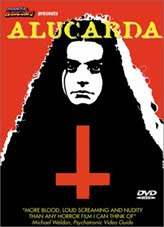
Alucarda
Original Title: Alucarda, la hijas de las tinieblas
Aka: Sisters of Satan
Directed by: Juan López Moctezuma
Mexico, 1978
Satanism / Occult / Possession, 85min
Distributed by: Mondo Macabro
Last week I discussed the heritage of Rodolfo Guzmán Huerta, and the phenomenon of El Santo, but don’t for a second think that Mexican genre cinema is all about Lucha Libre and masked heroes saving the day. Even though that specific niche may be the one most associated with Mexican sub-genres, there is still a goldmine of highly explosive movies come out of Mexico if you know where to search.

I would be wrong to slot this film into the nunsploitation genre even if this would seem fitting: Yes there’s certainly a whole lot of nuns engaging in battle with the evil forces at bay. Also it takes place in an orphanage/church where daily prayers and religious artefacts fill every scene. But there’s none of the backroom sleaze activity from the nuns, which usually characterizes the nunsploitation genre. It’s not the nuns that are sinful, but the poesies young women. (If you feel that taking your kit off and lesbian desires are sinful that is) Instead this is a good old possession movie where the devil corrupts the minds of young innocent women in his quest for world domination, with a healthy dose of exploitation traits at play.
The mood, tone and atmosphere of this movie is firmly set from the very start of the film. A young mother [Tina Romero in a double role as she later plays the grown up Alucarda too] gives birth to a little girl who, after being named Alucarda, is quickly taken by a strange old woman leaving the mother to face the strange entity that obviously is lurking the strange crypt like place she has chosen to give birth in…
Many years later, Justine [Susana Kamini, who starred in all of Moctezuma’s movies but the last one.] arrives at an orphanage where Sister Angélica [Tina French] greets her and shows Justine her new home. Justine is introduced to her roommate Alucarda [Tina Romero again] who comes right out and makes an impression of being quite eccentric and intense as she shows Justine her collection of secrets that she’s found out in the woods surrounding the orphanage. In reality it’s all pieces of twigs, dead beetles’ and small pebbles, but it set’s a naïve character trait that will be necessary to build the Alucarda persona. We understand that our impression of this peculiar young girl is the same as the other girls in the orphanage and realise that Alucarda is a loner without friends, which is why she so early on attaches herself to Justine, the new girl, so instantly. The new girl is a clean slate and holds no prejudice towards Alucarda.
They two friends run out into the woods to find more secrets and meet a hunchbacked Gypsy [Claudio Brook who you may recall from Guillermo Del Toro’s Cronos 1993, Robert Fuest’s satanic turkey The Devil’s Rain 1975 or one of the many Luis Buñuel movies he starred in. He also held the lead role in Moctezuma’s The Mansion of Madness (La mansión de la locura) 1973, and just like Romero holds double roles in Alucarda, as you soon will see.] Anyhow, the gypsy hunchback tries to sell the girls more “Secrets”, but his secrets are much more sinister than simple woodland titbits, and after running away from the creepy hunchback they find themselves in the crypt, or abandoned chapel from the opening birth sequence. Filled with adolescent curiosity they initiate a blood rite promising to be BFF’s and open one of the graves that they find there (possibly Alucarda’s mothers?) and the demonic forces start to arise. The audio is exhilarating here as the feeling is almost as if the sound producer has grabbed a mike and started growling and snarling into it right on top of the soundtrack. At first it is quite annoying, but the longer it goes on for the more profoundly it disturbed me. This trick is used throughout the rest of the movie, acting as a haunting audio key to indicate that the satanic forces at work are even larger than the movies narrative.
From here on the movie definitely goes into psychotronic land, safely back at the orphanage the girls undress and engage in a blood pact to stay friends for ever and never to walk the earth with out each other, and guess who shows up to interfere and lure them further into the darkness, yes it’s the hunchback. Inducting them into the pleasures of Satanism and blood rituals the heavens open up and blood pours from the skies. The Hunchback takes the girls with him out to the gypsy camp where a full-fledged satanic ritual is in progress. Nothing is held back as the naked participants engage in a huge orgy as Justine and Alucarda watch on in anticipation until the horned one makes his impressive entrance welcoming the girls into his dark world. At the same time Sister Angelica prays for her ward Justine, call upon the saviour the hardest she can, crying blood, sweating blood, levitating and begging the lord for Justine’s salvation. And would you believe it, in some kind of synchronized dance/possession Sister Angelica and the gypsy high priestess fight it out ever so elegantly, leaving Sister Angelica a crying mess, but successful and the high priestess dead in a pool of blood. The entire sequence is further propelled in surrealism as the before mentioned growling and snarling right in the front of the audio is right there adding to the visual wildness on screen.
The local doctor, Dr. Oszek [Brook in his second part] arrives just in time to witness Justine die at the hands of the Father Lázaro, or is it the evil forces that take her life as they have other plans for Justine… He damns Father Lázaro and the church for this outrageous act, but Father Lázaro defends himself by claiming that the girls are possessed by the devil and need to be set free, hence drastic action is demanded. Dr. Oszek takes Alucarda and his blind daughter out of the school and back to the safety of his own home. But have no fear for the movie is defiantly not over yet... As Sister Angelica prays by Justine’s body it starts to twitch, and the movie cranks it up to a higher level as it begins the build towards the coming fifteen minutes of climax that makes this one of the most amazing movies of cult cinema. Demons are fought, Justine bathes in blood, Nuns have their throats torn out, Fireballs are thrown, Monks are engulfed in flames, crucifixes burn, Alucarda brings hell to the ordinary world in an inferno of damnation. It’s good vs. evil in a battle older than mankind, and it is stuff that will blow your mind.

Upon watching Alucarda one could easily feel that this movie, in many ways like the Italian nunsploitation flicks, is anti clerical and a protest against the church, therefore choosing exposing their sinister sides and dark secrets, but I feel that the movie actually is more pro than against. For even though the clergy do kill Justine (in some ways she’s all ready lost due to the possession) Father Làzaro is right. The girls are possessed by the devil, and even the goody two shoes Dr. Oszek joins the church in the fight against the demons once his daughter is threatened. It’s splendid to see how easily lead on we are as an audience, and just how easy we are to manipulate. As Moctezuma has built the characters of Justine and Alucarda as young, naïve and innocent, we obviously take sides with them during the movie, hence directing us to root for the antagonists if you like. Yes antagonists. Justine and Alucarda are the evil forces of the movie, and the church; Sister Angelica, Father Lázaro and Dr. Oszek are the protagonists. It’s a wonderful trick when it works and Moctezuma pulls it off with bravura, as we don’t want the girls to be punished and want them to come out victorious against the forces of the church.
Finding his inspiration in Irish author Sheridan Le Fanu’s Carmilla text, Moctezuma and his co writers, among them his wife Yolanda, come up with a splendid story. It’s safe to say that Moctezuma makes the source material his own and uses the source material as an inspiration not a template. Although the gothic setting is preserved, the vampire element of Carmilla is abandoned; keeping the core - yearning for companionship and the extent you will go to for this camaraderie. Not to forget the controversial, well at least in 1872 when Fanu wrote it, homoeroticism especially the lesbian girl on girl elements. Exploring daring themes and using them in your text isn’t simply a ploy of seventies - eighties exploitation cinema; it’s been used since mankind started putting words on paper, and for some unexplained reason it provokes e heck out of certain people. Also Justine's name is a reference to De Sade’s Justine text, where the themes of good and evil, opposing oneself against accepted tradition, the corruption of the church and a young woman's coming of age are key elements.
Alucarda is a fascinating movie, the acting is splendid, the story is highly entertaining, Xavier Cruz's cinematography is marvellous, the compositions are stunning and at some times it’s almost like watching a theatrical presentation of the material. The movie is disturbing in many ways, one of the most effective is reminiscent of Tobe Hooper’s 1974 classic The Texas Chain Saw Massacre, and that’s the deafening audio track, screaming girls and growling demons make up a truly disturbing soundtrack. It’s a bold and innovative gamble that the sound crew and editors have taken, but in it’s own strange way it works in favour of the movie. Romero and Kamini scream as if their lives really where on the line, and the demonic growling placed up front make it impossible to escape the threat presented.
I’d say that the movie feels theatrical because of Moctezuma’s background in the theatre and radio. After working with radio, creating Panoama de Jazz in 1959, a show which aired for almost 35 years, Moctezuma set his eyes on the area that had always inspired and enticed him, Cinema. His road there went via several TV shows, a number of short movies and his assistant work with theatre legend Seki Sano.
Seki Sano was an exiled Japanese director and writer of theatre who spent time in prison after being accused of spreading socialist ideas through his work. Sano spent some years in the then USSR where he associated and worked with the likes of Stanislavski and Meyerhold, before moving on to America. But even there his “radical and socialist” ideas where criticized and he ventured further south ending up in Mexico during 1939. Here he would become somewhat of a key figure for the next generation of belligerent players on the Mexican scene. It is probably during his time as an assistant to Sano that Moctezuma picked up his method of writing, acting, directing and the theatrical grandeur that comes with his movies. It's also during this time that he befriended the Chilean multiartist and creative shaman Alejandro Jodorowsky.
Teaming up with his new friend Jodorowsky, Moctezuma worked with him on Fando y lis 1967 and the midnight classic El Topo 1970, for which he both received producer credits on. It was only a question of time before Moctezuma himself would direct his own full length features, and in 1973 Moctezuma wrote and directed The Mansion of Madness loosely based on Edgar Allen Poe’s The System of Doctor Tarr and Professor Fether. Just like Jodorowsky, Moctezuma regarded his art passionately and held it close to himself on a personal level which had him refuse compromising with his principles and, again just like Jodorowsky, he was quite rigid, which is one of the reasons why he only directed a few movies during his career. It’s all about quality and not quantity for visual directors of Mocetezuma's stature.
But those five movies still hold up today as the surreal art house horror crossovers that they where intended to be. Themes, style and elements of the fantastic played for real in some of the most fascinating movies you will ever see.
Image:
Full screen 4:3, which presumably is the OAR.
Audio:
Dolby Digital Stereo with English or Spanish dialogue options.
Extras:
Juan Lopez Moctezuma – A Cultured Maverick: A short documentary on the director and his movies, Theatrical Trailer, a gallery of stills and photos. Interview with Guillermo del Toro on the legacy of Moctezuma. There’s also a text interview with Moctezuma and cast and crew biographies.
Disney Star Wars and the Kiss of Life Trope... (Spoilers!)
Here’s a first… a Star Wars post here. So, really should be doing something much more important, but whist watching my daily dose of t...
-
There’s an old rumour on the Internet that originates from one of Andrei Tarkovsky’s diary entries that tells of a horror film he once saw ...
-
Here’s a first… a Star Wars post here. So, really should be doing something much more important, but whist watching my daily dose of t...
-
Cannibal Holocaust Directed by: Ruggero Deodato Italy 1980 Horror/Cannibals, 95min The cannibal genre, an odd little bastard offspring in It...

